Universality class of the two-dimensional polymer collapse transition
Author(s)
Nahum, Adam
DownloadPhysRevE.93.052502.pdf (809.2Kb)
PUBLISHER_POLICY
Publisher Policy
Article is made available in accordance with the publisher's policy and may be subject to US copyright law. Please refer to the publisher's site for terms of use.
Terms of use
Metadata
Show full item recordAbstract
The nature of the θ point for a polymer in two dimensions has long been debated, with a variety of candidates put forward for the critical exponents. This includes those derived by Duplantier and Saleur for an exactly solvable model. We use a representation of the problem via the CP[superscript N−1]σ model in the limit N → 1 to determine the stability of this critical point. First we prove that the Duplantier-Saleur (DS) critical exponents are robust, so long as the polymer does not cross itself: They can arise in a generic lattice model and do not require fine-tuning. This resolves a longstanding theoretical question. We also address an apparent paradox: Two different lattice models, apparently both in the DS universality class, show different numbers of relevant perturbations, apparently leading to contradictory conclusions about the stability of the DS exponents. We explain this in terms of subtle differences between the two models, one of which is fine-tuned (and not strictly in the DS universality class). Next we allow the polymer to cross itself, as appropriate, e.g., to the quasi-two-dimensional case. This introduces an additional independent relevant perturbation, so we do not expect the DS exponents to apply. The exponents in the case with crossings will be those of the generic tricritical O(n) model at n = 0 and different from the case without crossings. We also discuss interesting features of the operator content of the CP[superscript N−1] model. Simple geometrical arguments show that two operators in this field theory, with very different symmetry properties, have the same scaling dimension for any value of N (or, equivalently, any value of the loop fugacity). Also we argue that for any value of N the CP[superscript N−1] model has a marginal odd-parity operator that is related to the winding angle.
Date issued
2016-05Department
Massachusetts Institute of Technology. Department of PhysicsJournal
Physical Review E
Publisher
American Physical Society
Citation
Nahum, Adam. "Universality class of the two-dimensional polymer collapse transition." Phys. Rev. E 93, 052502 (May 2016). © 2016 American Physical Society
Version: Final published version
ISSN
2470-0045
2470-0053